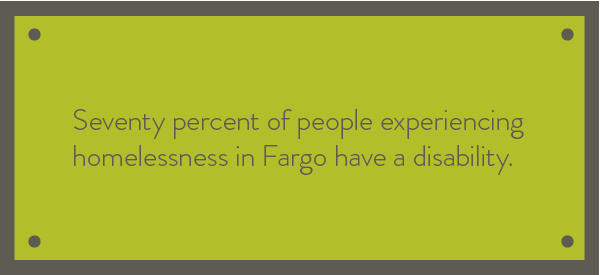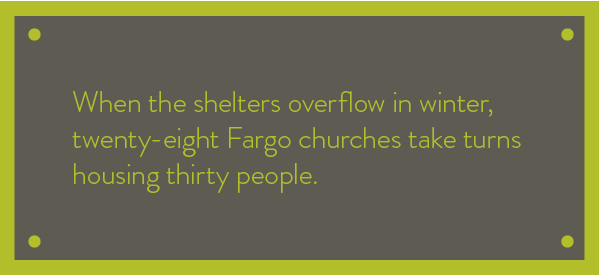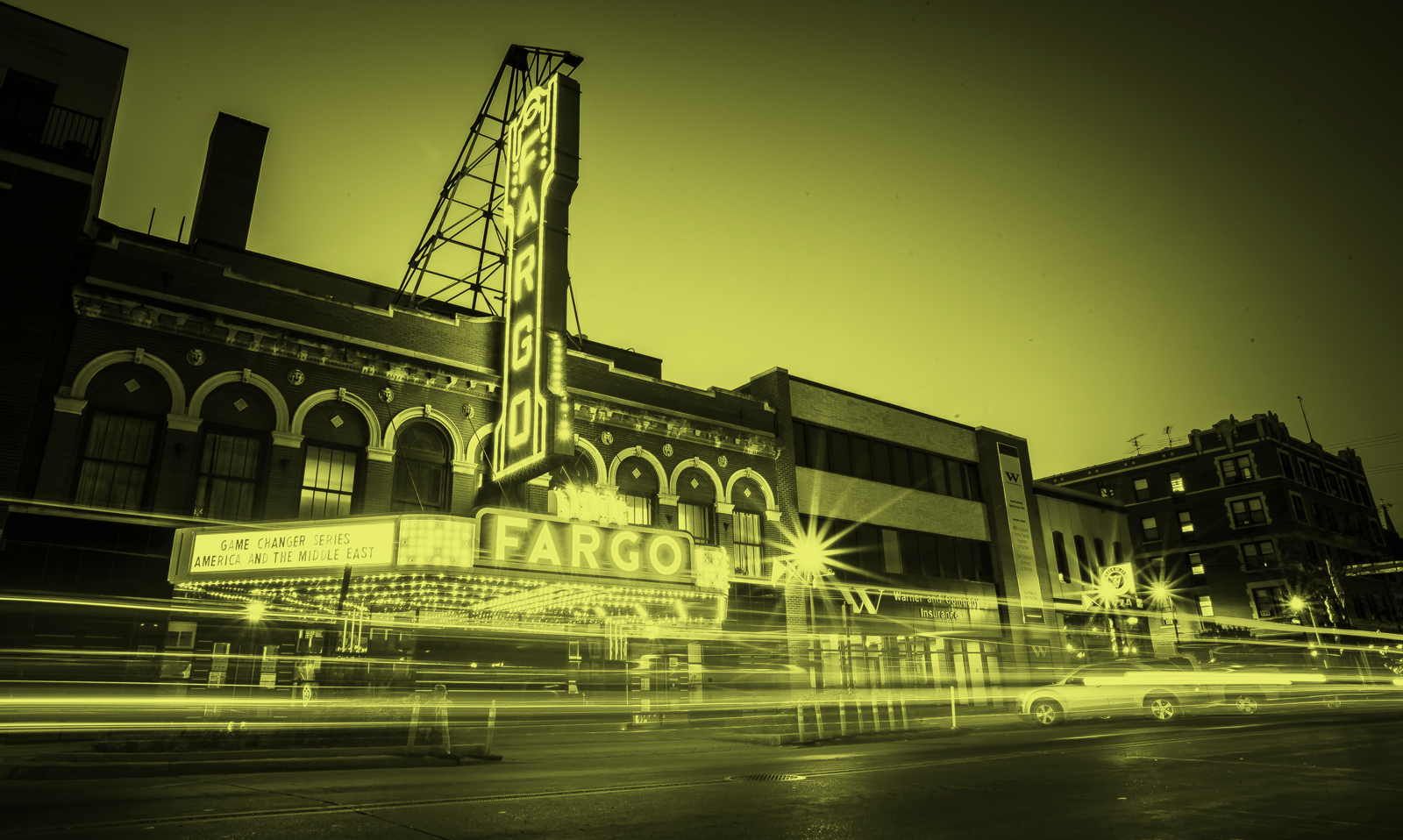
Words and illustration by Morgan Mercer
Change is happening in Fargo. A city once synonymous with expansive stretches of grassland and farms, Fargo is now growing to fill out its new reputation as a creative capital on par with other mid-size cities such as Minneapolis, Austin, and Portland.
A revitalized downtown. A high-tech hub. Retention of young talent.
It’s a far cry from the period of dilapidation and decline the city emerged from — a time when downtown buildings were boarded up and people left in droves. These days, positive attributes are abound — investment in buildings and infrastructure, increased economic activity, and new creative ventures.
But as a city’s character and culture evolves, not everyone experiences a net win. Laurie Baker, executive director at Fargo-Moorhead Coalition for Homeless Persons, sheds light on how the economic and oil boom affects the homeless population she and her organization fight daily to help.
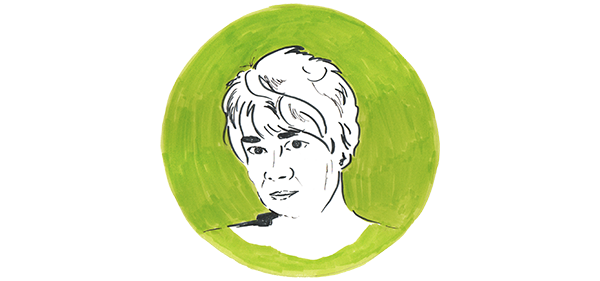
In 1989, your organization was established in response to four shelters voicing concerns over the rising rates of homelessness in the area — rates that were higher than the national average. How do the rates compare today? Are you worried they might change as a result of the growth and economic development happening in the area?
Our rates continue to be high. I don’t know where we rank in the national scene, although with North Dakota’s economic boom I expect we rank high. People migrate for opportunity and don’t always bring the skills, resources, and supports needed for integration into a community. My biggest frustration with the boom is what I see as a failure of state leadership to reflect on the difficult aspects of rapid economic growth, to help communities manage change, and to provide for the “underbelly” aspects such as increased poverty and homelessness.
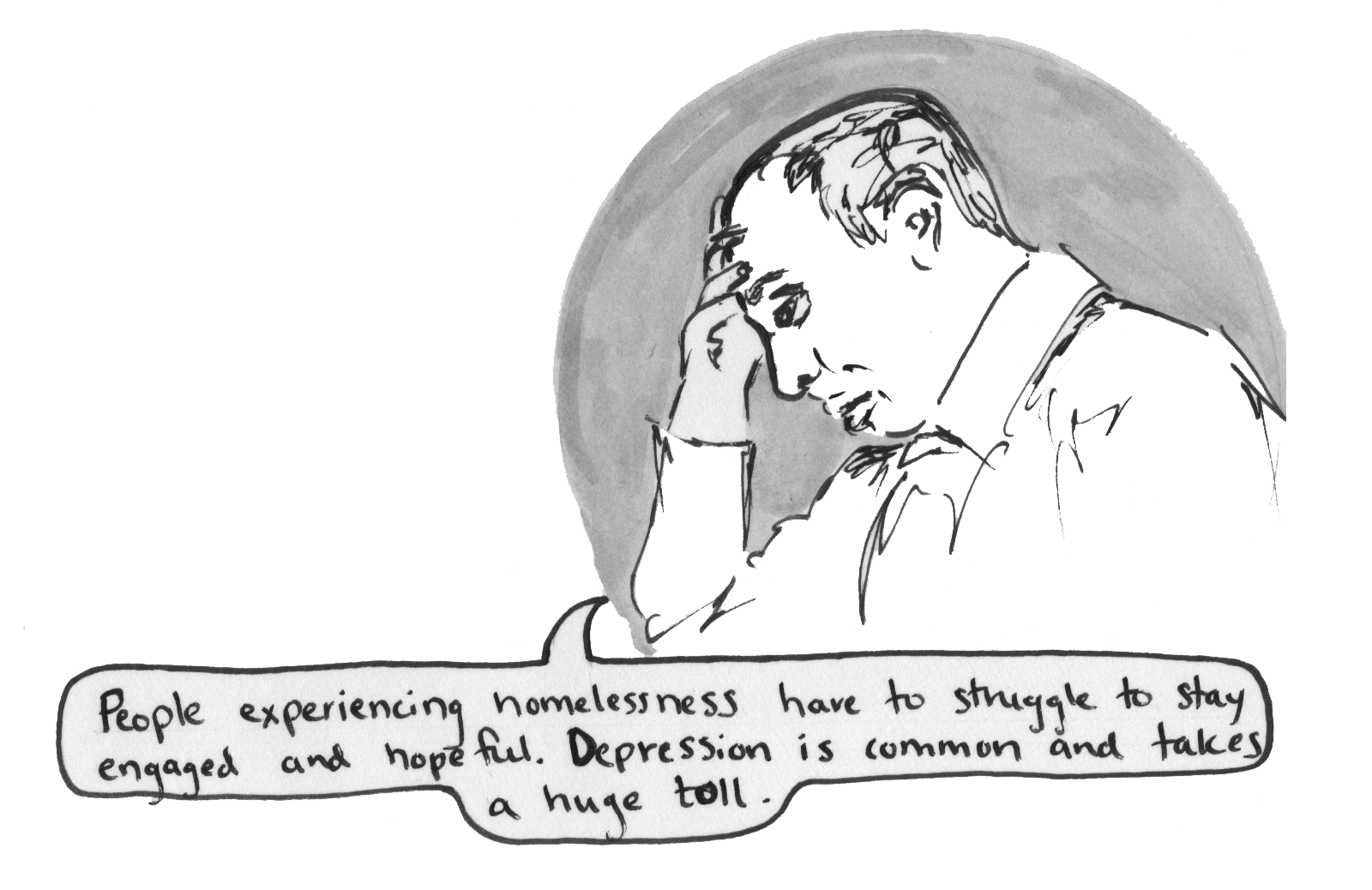
We’ve definitely seen the impact of the boom in Fargo-Moorhead. Both newcomers to the state and long-time residents migrated to Fargo when housing in the west was unavailable or prohibitively expensive. Fargo-Moorhead has the most robust homeless service system in the state, so it’s a natural consequence. It has been somewhat overwhelming, especially for the emergency shelters and Homeless Health. However, the situation for our colleagues in western North Dakota is truly overwhelming, so we are doing our best to forge ahead and count our blessings.
Back in 2006, the 10-year plans to end homelessness were put in place. There seemed to be a lot of energy around the issue at that time. Is that attitude still going strong and do you feel your community prioritizes fighting homelessness?
I’m proud I live in Fargo-Moorhead. I think of our little metro as a community of compassion. We have figured out how to collaborate across our multiple geo-political divides. I believe our city leaders understand the solid economic benefits of preventing and ending homelessness and they contribute both resources and expertise to the work. For example, both city planning offices are Coalition partners and regularly attend meetings and participate in working groups. We continue to have a lot of energy around putting the action items of the 10-year plans into place. We’re actually governed by eight 10-year plans. Thankfully, they have a lot in common. I tend to work from Fargo’s plan because I find it very clear and easy to monitor.
We have a standing committee called Ending Long-Term Homelessness whose charge is monitoring the plan and choosing next steps. As a process, it has worked well. We’ve steadily tackled action items and made lots of progress in implementation. I believe the only reason we continue to see numbers of people experiencing homelessness so high is because of the boom.
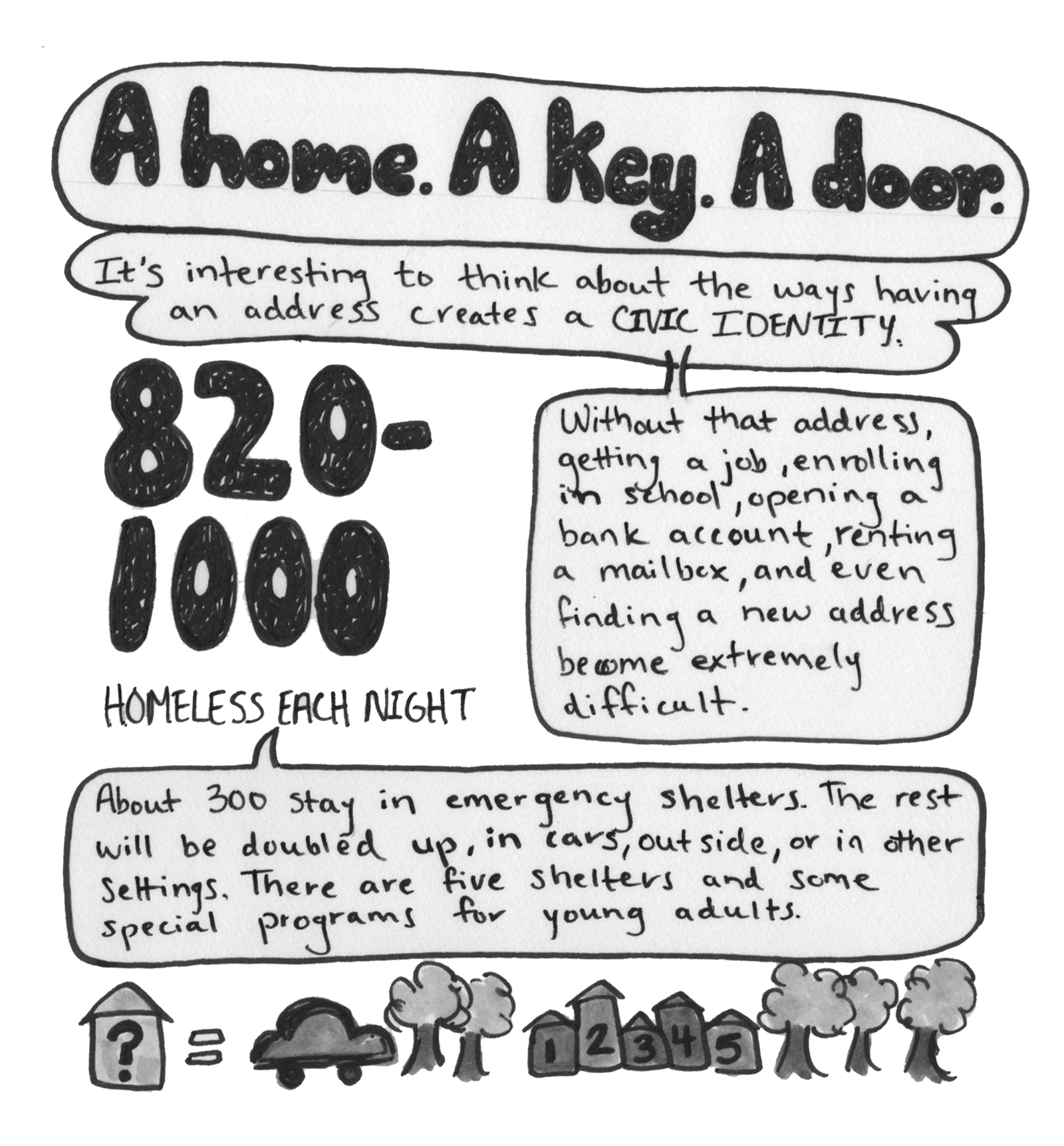
How do you feel about the economic development Fargo is experiencing? In what ways does it hinder or aid your work and population you serve?
I love the economic development in Fargo-Moorhead. Downtown Fargo in particular looks and feels energized and urban. It has changed the landscape for a segment of the very poor — the middle-aged men who make up the majority of the long-term homeless population — because single room occupancy housing was eliminated to clear the way for new developments. I think it creates opportunity to do better by those men, and I see efforts to provide intelligent, affordable, and supportive alternatives happening all around.
Has the population you serve changed with the economic and oil boom?
Homeless Health and the emergency shelters both report seeing signs of more violence — fights and assaults. That is different and disturbing, especially since they are unreported crimes. Street justice essentially forbids people living rough from reporting anything to law enforcement. Men who have been long-time residents of the Fargo-Moorhead homeless community speak sadly of the loss of their culture and of outsiders who don’t know how to behave.
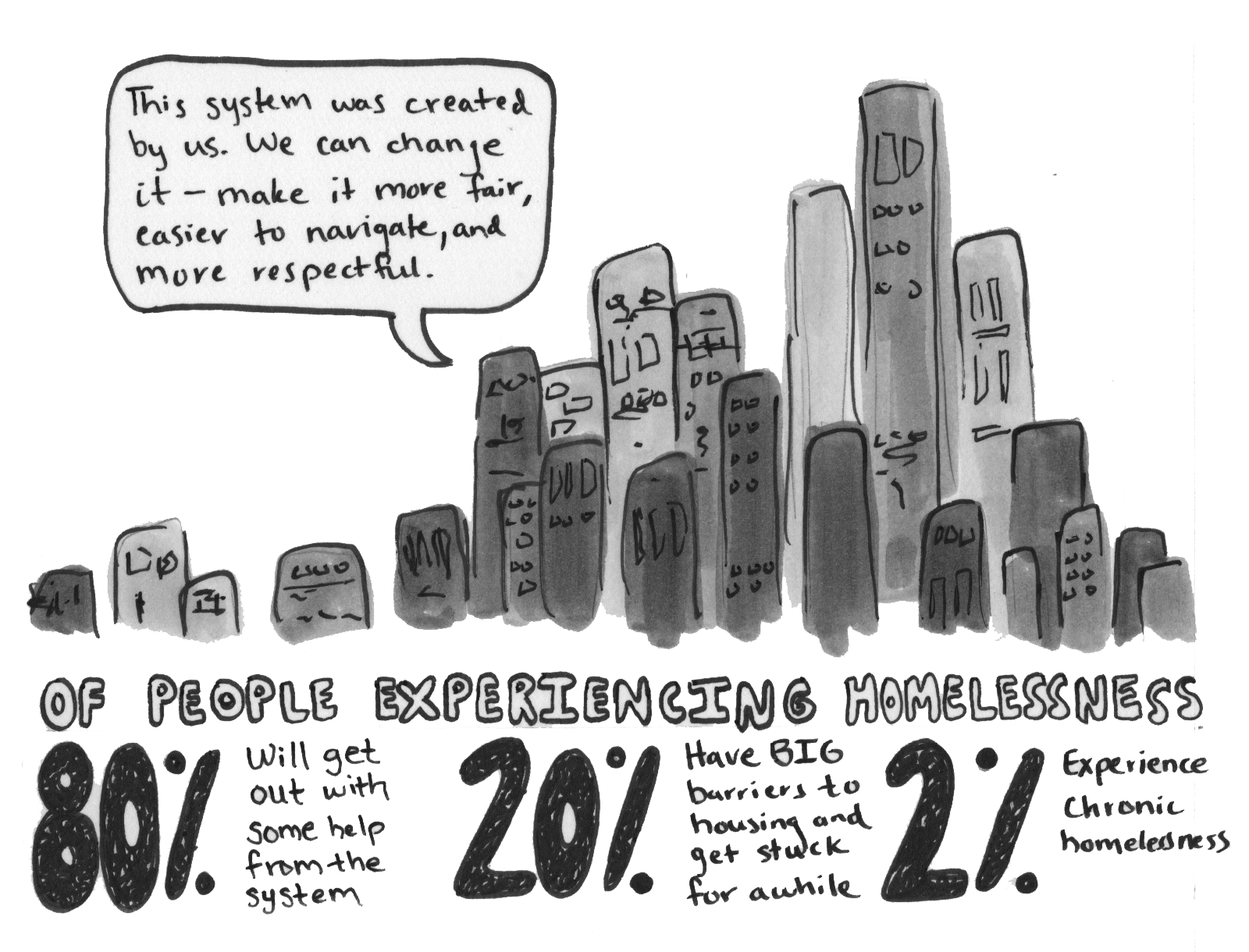
How can you structure economic development to ensure vulnerable, at-risk, and homeless populations are protected and successful too?
Avoid sprawl. Someone just told me that our footprint here is larger than Boston or San Francisco, with a fraction of the population. The more spread out we are, the harder it is for poor people to get to what they need. Transportation is our biggest issue after housing. Right now housing is very expensive in downtown Fargo, but all the public transportation is centered there. We need a mixed demographic everywhere; it’s how you achieve a healthy, happy diversity.
How does the community at large benefit from driving down the homelessness rate?
Homelessness is incredibly expensive — both in real dollars and in damage to the people experiencing it. Imagine having to replace all your stuff because you’ve had to walk away from it, perhaps several times. It’s also the cost of social services and emergency shelters, health care via emergency rooms, and justice system engagement (because much that is legal inside your home is not legal outside it). It is cheaper to house people than to leave them homeless — this has been demonstrated over and over again all across the country. Nevada’s Million-Dollar Murray may be the most expensive example of what happens when we don’t address homelessness, but we have people in Fargo-Moorhead who cost the community more than $100,000 a year. I’d estimate an average household costs the community $40,000 or $50,000 while homeless. And remember, almost no one was born homeless and only a tiny fraction of people experiencing homelessness choose this way of living. Homelessness is hard. It’s traumatic. It’s often humiliating, and it’s most definitely criminalized.
Your organization values cultivating partnerships with other groups. What is the value in working collaboratively, and is there a way you could use the increasing economic development to your advantage?
We have to learn to speak business. We have to speak logically as well as emotionally. The Leadership Fargo program of the Chamber of Commerce gave me some help with this in the last year. We’ve also deepened our working relationship with the faith community. If the only people at the table are social service people, I’m not sure that is collaboration, although it’s a great place to start. Once we get out of our own silos and tour a few others, we see the ways our differences and similarities complement and bond us. Then we can reach and teach others. Something has made it possible for Fargo-Moorhead to have a very strong homeless coalition, and it’s not simply the people. Other regions of North Dakota seem to lack this strong collaborative effort around homelessness, even though they’re every bit as well intentioned as people here.
Photo courtesy of Kilbourne Group. Thank you to photographer Rick Abbott.
